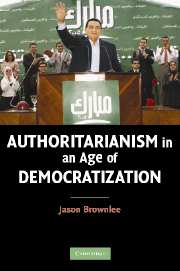Book contents
- Frontmatter
- Contents
- List of Figures and Tables
- Abbreviations and Acronyms
- Acknowledgments
- Introduction: Authoritarianism in an Age of Democratization
- 1 The Political Origins of Durable Authoritarianism
- 2 The Inception of Ruling Parties
- 3 Institutional Legacies and Coalitional Tensions
- 4 Ruling Parties and Regime Persistence
- 5 Elite Defections and Electoral Defeat
- 6 Confrontation and Democratization
- 7 Conclusions
- References
- Index
6 - Confrontation and Democratization
The Philippines during the Third Wave
Published online by Cambridge University Press: 05 June 2012
- Frontmatter
- Contents
- List of Figures and Tables
- Abbreviations and Acronyms
- Acknowledgments
- Introduction: Authoritarianism in an Age of Democratization
- 1 The Political Origins of Durable Authoritarianism
- 2 The Inception of Ruling Parties
- 3 Institutional Legacies and Coalitional Tensions
- 4 Ruling Parties and Regime Persistence
- 5 Elite Defections and Electoral Defeat
- 6 Confrontation and Democratization
- 7 Conclusions
- References
- Index
Summary
In contrast to durable authoritarianism in Egypt and Malaysia and a squandered opportunity for democratization in Iran, the Philippines provides a case of authoritarian breakdown and democratization. The movement to end Marcos's dictatorship combined elites and mass support in an inspiring push to restore representative government. As in the three cases already examined, this dramatic outcome was one effect of an extended process whose roots long predated the third wave. Marcos suffered from the same institutional deficit that plagued prior generations of Philippine leaders: The nation's political groups did not provide a stable home for elite coalitions. Indeed, Marcos's own successful jump from the Liberal Party to the Nacionalista Party in pursuit of a 1965 presidential nomination epitomized the elite disunity that plagued the Philippines. Once he controlled the country, Marcos let his coalitional ties atrophy as he concentrated power among a much smaller set of clients drawn from his friends, family, and home region. It is in this context – the freezing of the Nacionalista Party, the privileging of personalism over political affiliation, and the subversion of accepted hierarchies for advancement – that one must situate any understanding of Marcos's regime and its eventual downfall.
The tale of elite defections and counteralliances in the Philippines adds another layer to our understanding of the role of moderation in democratization.
- Type
- Chapter
- Information
- Authoritarianism in an Age of Democratization , pp. 182 - 201Publisher: Cambridge University PressPrint publication year: 2007



